|
The Celebrity Collector
Clinton Derricks
collects golliwogs black figures made popular in story books over 100 years ago in
Britain
By Ken Hall
Clinton Derricks was already a collector of black memorabilia
when he strolled into an antique shop in Hollywood in 1984 and saw something
he'd never laid eyes on before: a golliwog doll, still in its plastic wrapping.
"What's that?" Derricks asked. "That's a golliwog," the storekeeper said, and
thus began a collection for the actor-singer that today encompasses hundreds of
golliwog items.
His immersion into golliwogs a British phenomenon
culminated last year in the publishing of a book he wrote titled Buy Golly! (New
Cavendish, distributed in the U.S. by Antique Collector's Club, $35). "My
apartment in Hollywood looks like a museum," Derricks said with a laugh. "I've
got dolls, toys, books and ephemera on shelves, on walls, everywhere. It's very
ordered and tasteful."
The golliwog doll actually began life as a storybook
character created in 1895 by Florence Kate Upton, a writer living in New York
before returning to England with her family. Her first book, The Adventures of
Two Dutch Dolls, was an instant hit with kids in Great Britain. But it was a
character based on a doll Upton owned as a child that became the star. She named
the doll on a whim:
"He fell into our hands when we were children," Upton
wrote. "He came from an American Fair, and in those days he was nameless. I
picked him up in my studio, and without even the idea of a name passing through
my head, I called him 'Golliwogg'" (The second "g" was later dropped.) She would
go on to write a dozen more books, all with Golliwog in the title. That's how
popular he was.
Golliwog was a caricature of the American black face minstrel
performers of the time. Derricks said the argument could be made that Upton
meant for him to be more gnome-like, but the golliwog's features round eyes,
thick lips, fuzzy hair and broad grin fed into a racial prejudice that was
endemic in Victorian Edwardian Britain. A flood of golly-related items only
perpetuated that.
By the 1960s, the golliwog and other similar emblems were
seen as symbols of racism. They faded from shelves for the most part, although a
handful of companies still make the golliwog dolls and related items today -
mostly as modern-day relics of another time and place (one best left in the
past, many would say). Over the years, though, millions of golliwog items were
mass-produced.
Many of those items have found their way into Derricks'
collection, thanks in part to an acting gig in London that resulted in his
living there for more than a decade (1985-1996) and permitted him to shop for
vintage gollies right where they were born. "I gobbled up everything I came
across at first," he said. "Later on, I got a bit more discerning, but I was
very much into the history and lore."
Among his prized items are
first-edition copies of Upton's books, including the first one in the series; an
original Merrythought doll from the 1930s (Merrythought produced golliwog dolls
in Britain for years and still makes them today); an original golliwog doll from
Gamages' department store in 1902 (where they were first sold); and a 1913 doll
from Atlas Manufacturing, another maker.
A group of three golliwogs are
particularly prized for their uniqueness: a soldier golliwog dressed in British
khaki uniform (quite rare); a girl golliwog (not many of the dolls were depicted
as girls); and a third doll, with blue jacket, red trousers and red bow tie.
"They were made around 1910-1912," Derricks said. "I bought them at auction in
London. They're beautiful vintage pieces."
He also has an original Allwin
doll from 1924 (Allwin, or Richards Son Allwin, was another primary player back
in the doll's heyday). "It's a Ringmel green golliwog, made of felt, with an
orange nose," Derricks said. "It looks a little like a clown." He also has many
badges, placards and advertising signs from Robertson's, a jam maker that used
the golliwog as its mascot for over 20 years.
Once, in London, Derricks
scored a coup over actor and fellow collector Whoopi Goldberg. "I saw a pair of
Chad Valley (another manufacturer) dolls on tricycles, and I asked the
shopkeeper how much. He told me he was holding them for Whoopi Goldberg, I told
him it might be anybody's guess when she'd be back in England. He eventually saw
things my way and sold me the pieces."
Most of the items in Derricks'
collection are older, vintage items and one-of-a-kinds. He has it all insured
(for an undisclosed amount), but has no idea as to its aggregate worth. "I know
what I've spent over the years, and it's quite a bit, so I'm sure it's
valuable," he said. He added golliwogs have caught on as collectibles in other
countries notably the United States, Australia and even Japan.
Derricks
has other collections, too. He owns three vintage pedal cars; jukeboxes from the
'40s (two Rock-Olas and a Seeburg); several carousel horses; vintage watches;
and vintage cars and motorcycles, to include a 1968 MGC sports car, a 1967 TVR
"kit car," a 1949 Citroen Legere, a 1970 Italia Spyder once owned by the actor
Lyle Waggoner, and a 1964 Matchless trials motorcycle.
To research Buy
Golly!, Derricks poured through books and other material at the London Library,
Pollock's Museum and the London Toy Museum all in England. He also became
familiar with the fabrics, buttons and other materials that went into making the
early gollies. "Much of that material was destroyed, or went into two war
efforts," he said. "That's why they're so rare today."
Clinton Derricks was
born May 15, 1959, in Knoxville, Tenn. His father was a Baptist minister and his
mother was an aspiring concert pianist before joining her husband in the church.
Clinton (along with his twin brother Cleavant, who would also go on to enjoy a
career in acting and music, and sister, Gwendolyn) grew up in Knoxville, Jackson
(Tenn.); Beloit, Wis., and Washington, D.C.
As their father took on
ministries in different parts of the country, the family moved with him, and it
exposed young Clinton to many influences and levels of acceptance and racial
prejudice. He said the prejudice he and his brother encountered in Washington,
D.C., was far worse than anything he experienced in Beloit, Wis., which is
predominantly white. "We had a rough time in D.C." he said.
Acting wasn't on
his mind when he enrolled at Federal City College in Washington, D.C., in the
mid-'70s. He was (and still is) artistically inclined, and selected studio art
as a major. But he had always sung in the church choir and grew up around music
all his life, so when an opportunity came to audition for a role in a touring
company version of "Don't Bother Me, I Can't Cope," he took it.
He got an
understudy role and was encouraged by the cast members who told him he was a
gifted talent who could act and sing. Inspired, he left school and moved to New
York City, where he came under the wing of producer-director Vennette Carroll.
She was so helpful in getting Clinton's career started he considered her a
second mother and often uses the name Clinton Derricks-Carroll.
Derricks'
stage credits include appearances on Broadway ("I Have a Dream," "Dreamgirls,"
"Your Arms Too Short to Box With God"), British theatre ("Time," "Miss Saigon,"
"Grand Hotel") and television ("Introducing Dorothy Dandridge," "Sanford," Hill
Street Blues," "Highway to Heaven," "The Steve Harvey Show"). He just concluded
a stage production in Los Angeles, a tribute to Ruby Dee.
Projects in the
works include a possible to return to the British stage (he didn't want to jinx
it by naming the play). Meanwhile, Derricks stays busy restoring carousel
horses, playing the guitar and saxophone (he's trying to master both) and
maintaining his golliwog collection. He plans to write another book, this one
about the many black and white celebrities who collect black
memorabilia.
Fans of Clinton Derricks may write to the star c/o Jan Ross,
Gollyfest, P.O. Box 1634, Mill Valley, CA 94942. The e-mail address is
gollyfest@aol.com.
|
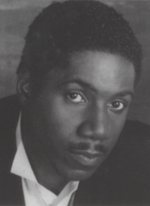 Clinton Derricks has appeared on Broadway ("Dreamgirls," "Your Arms Too Short
to Box With God") and television ("Sanford," "Hill Street Blues").
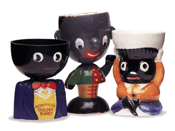
Three golliwog egg cups, from left: Robertson's, plastic, 2-1/2", 1960s;
Fairylite 'Noddy' type, wood base, 3-1/2", 1960s; China egg cup, British,
2-1/2", 1920s.
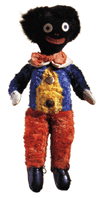
This is the first silk plush golliwog from Merrythought, a British doll maker
that still produces gollies to this day.
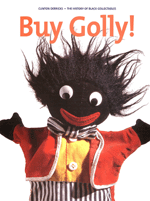
Derricks' passion for collecting golliwogs led him top write a book on the
subject titled "Buy Golly!" It was published last year by New Cavendish Books
($35).
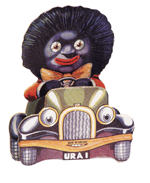
Golliwog squeaker toy, lithographed cardboard (British, 5" tall, ca.
1930s).
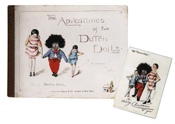
The golliwog doll was first introduced in an 1895 book titled "The Adventures
of Two Dutch Dolls," by Florence Kate Upton. Derricks has a rare first-edition
copy.
|